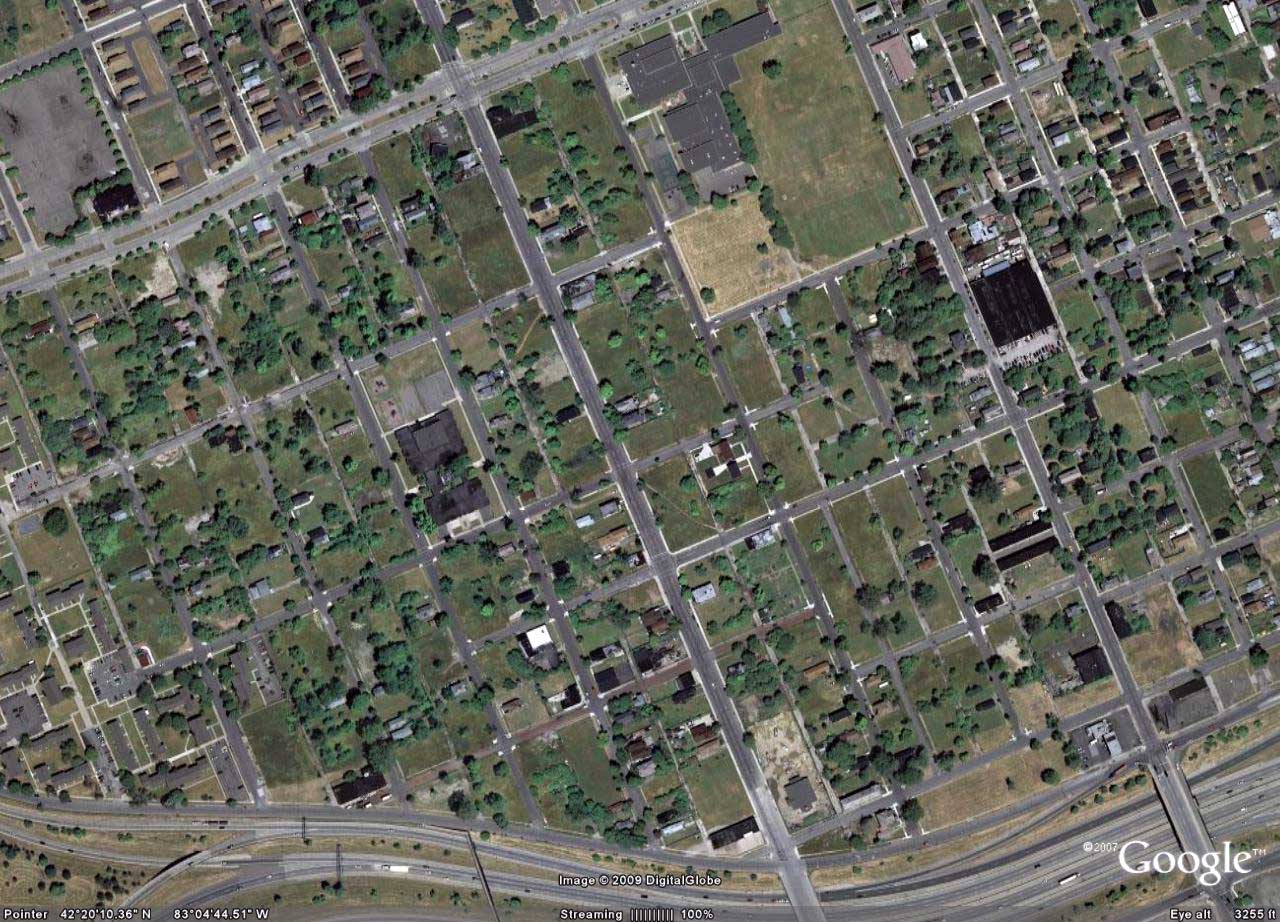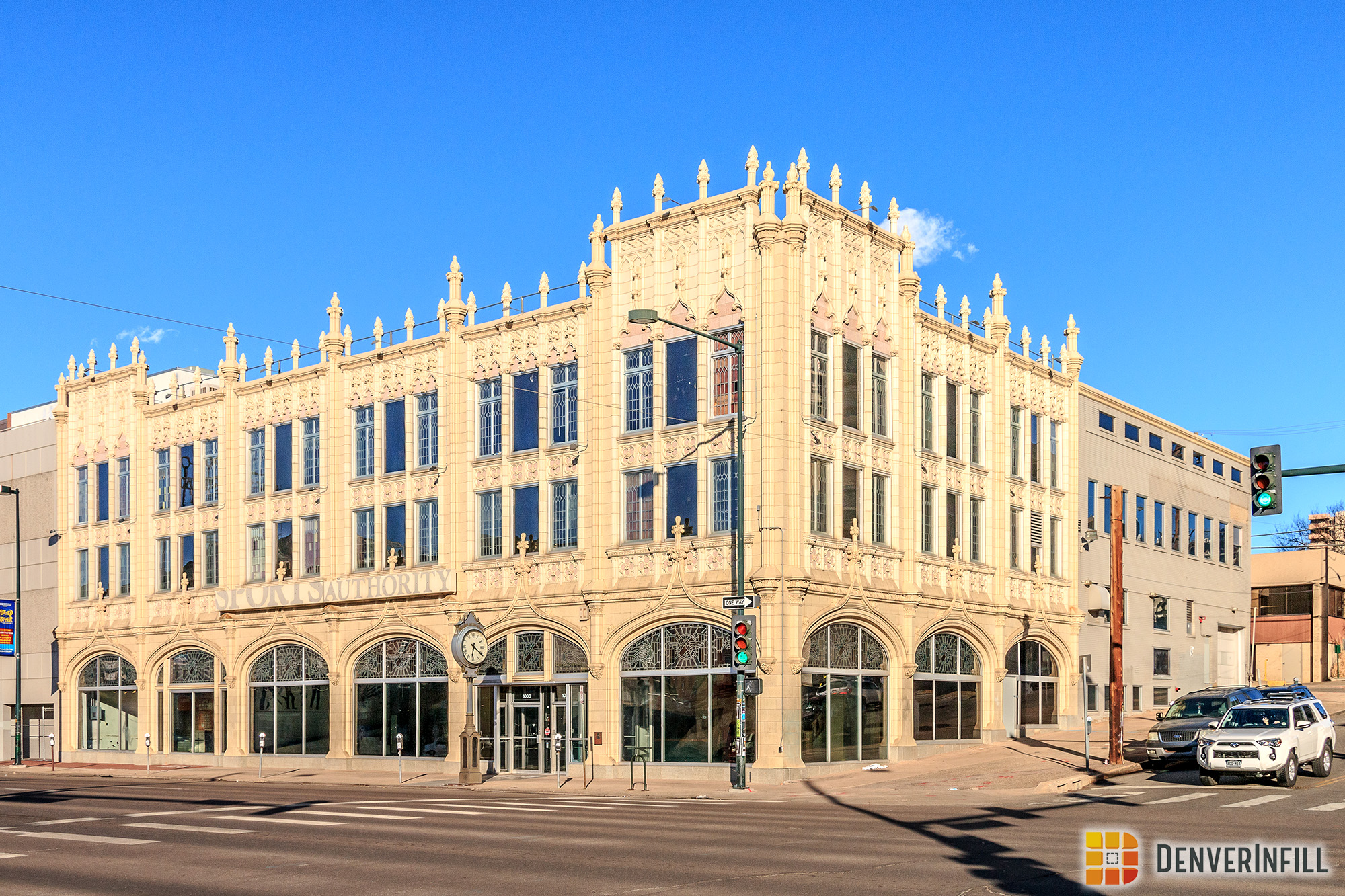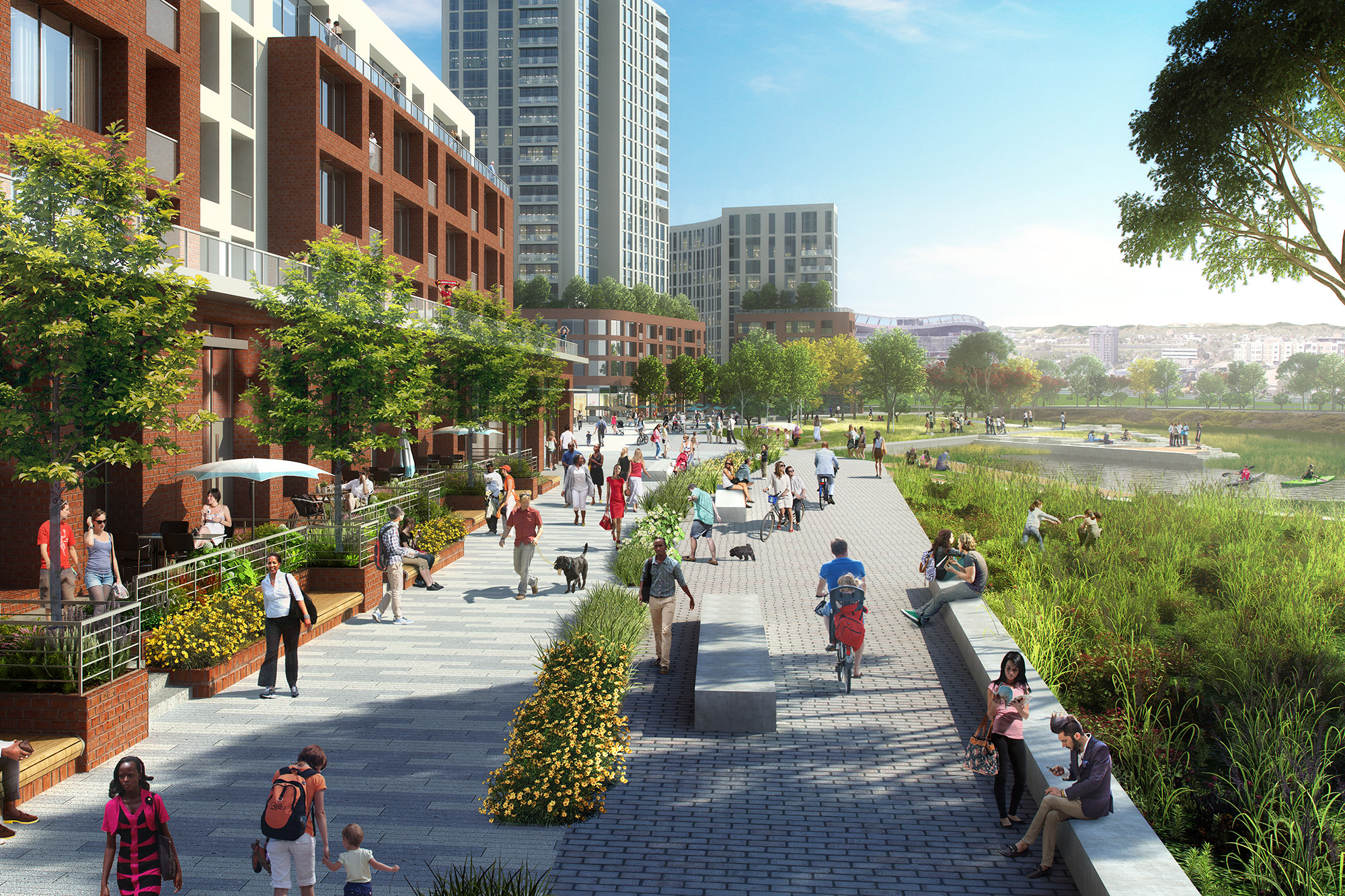I’ve just returned from a week of visiting family out of town, and one of those trips took me to Michigan, where I once again had the opportunity to drive through Detroit.
In the 1950 census, the city of Detroit’s population peaked at 1,849,568. In 2000, the city’s population was 951,270, and SEMCOG, metro Detroit’s equivalent to Denver’s DRCOG, estimates Detroit’s 2008 population at 860,521. Physically, what happens to a city when it loses half its population in 50 years? The answer is visible from driving along Interstate 94 as it cuts through the heart of the city, where one can see hundreds of vacant or burned-out buildings overlooking the sunken freeway. But to really appreciate the degree to which many of central Detroit’s neighborhoods have been abandoned, explore the city using GoogleEarth. First, find Downtown Detroit along the Detroit River, then venture northwest, north, and northeast from there, and you will be shocked at what you see:
Talk about infill opportunities! These images represent just a few examples of the extent of urban abandonment in Detroit. It’s surreal to see block after block of a city grid with virtually no homes or buildings lining the streets. Between 1970 and 2000, over 161,000 homes and buildings were demolished in the city of Detroit, with thousands more razed every year. Nature is reclaiming many of these empty blocks, with native grasses and trees thriving and turning these once-dense inner-city neighborhoods back into greenfields. One Detroit city councilperson even suggested that the city should relocate any remaining residents from these abandoned neighborhoods, fence the areas off, and let them transform into nature preserves.
To give you an idea of the expanse of these empty inner-city Detroit neighborhoods, here are three aerial images from Denver taken at the same scale (eye altitude). From left to right: the West Highlands neighborhood centered on 32nd & Lowell, the West Washington Park neighborhood, and Capitol Hill west of Cheesman Park. Can you imagine these Denver neighborhoods being virtually empty of buildings or people?
For an in-depth look at Detroit’s sad situation, check out this article, Disappeared Detroit, from Lost magazine.
My purpose in discussing Detroit is not to compare that city to Denver, but to emphasize, using Detroit as an example, the importance in being vigilant in maintaining the vitality and quality of our urban core. I’m sure no one in Detroit in the early 20th century during the peak of that city’s wealth and prominence could have believed that Detroit could decline in a free-fall so far, so fast. Such is the case in Denver today, as we mostly dodged the bullet of severe urban decay that struck so many other cities in the 1970s and 1980s and now find ourselves twenty years into an era of great revitalization and investment in our urban center. We cannot rest on our laurels and assume that Denver will forever remain the thriving heart of a sprawling metropolis. Every day, we must work hard to make sure that what happened to Detroit never happens to Denver. That is one of the reasons why I created DenverInfill.
We are blessed here in Denver to have such a solid fabric of stable, historic urban neighborhoods: Capitol Hill, Highlands, Sloans Lake, Washington Park, Park Hill, Berkeley, Baker, Hilltop, Bonnie Brae, Cherry Creek… just to name a few. Can you imagine Denver without them? I hope everyone reading this finds some way to help keep Denver the vibrant, beautiful city that it is.
















I think the lesson from Detroit isn't so much about maintaining your urban core, but more of basic economics. When your city lives and thrives off a single economic monoculture (automobiles) your city thrives or dies at the whims of that single industry. I am sure Detroit would have loved to maintain a beautiful downtown, but no jobs = no taxes = no money. Don't mix up causation and correlation.
OMG! You are so right Ken. Wow I had no idea and I don't think most people do as these types of urban decay aren't paid attention to outside of their local community government and media networks are they? I would assume that Detroit is ashamed of this blight to the point of withdrawal. I can see this also as an opportunity for some kind of economic stimulus package from the upcoming administration.
It really is sad to see what has happened in Detroit. I was there last January for the North American International Auto Show, and it was depressing. Even downtown, the ground floors of tall buildings were vacant, whereas in Denver, they are all filled with retail. You can almost picture Detroit in its heyday, in the middle of the last century when American automobiles were among the finest in the world. We need to make sure this doesn't happen to Denver. Hopefully the tragic financial situation in Detroit will improve soon, and the city will begin to improve. However, I should mention that I did stay at the 72-floor GM Renaissance Center Marriott Downtown, and it was quite nice!
Great posting, Ken. I've never visited Detroit, but people that I know who have have reported similar things. One of the biggest losses was the old J.L. Hudson department store downtown…something like 20 stories, one of the largest department stores ever built. Several years ago it was demolished without ceremony. Were it in Denver, today it would be vibrant loft or mixed-use building.
Despite the state of the inner city, Detroit's suburbs are very wealthy places indeed, although unless the Big 3 make it back from the brink they won't be for much longer.
I think that city council person is right: they should re-use those abandoned neighborhoods, but not as nature preserves. Rather, they should be turned into urban farms–it's the wave of the future (read Bill McKibben's Deep Economy).
–historymystery
Chris,
Regarding your comment about economics and relying on one particular industry – the sad state of Detroit is more complicated than that. The race riots ruined that city – plain and simple – starting in the 40's and culminating in the 1960's. Going into the 70's, the elected officials were predominately black and were viewed to be "antagonistic" toward the white community (probably matters what side of the fence you're on), but regardless it resulted in a mass exodus of white people from the city, thus coining the term "white flight". And as a result, there went the tax base.
Today, the suburbs of Detroit are very wealthy, but it's a shame that they were ever created in the first place. The problems with the auto industry have just made a bad situation worse.
Please- Detroit is a lost cause, do not abandon the fine work you've done for Denver,we need all you're help.
In Philly, hate it, thinking of moving back…
Wow. That article blew my mind. I always knew Detroit had a shrinking population and an abandoned building problem, but I didn't realize the extent of it. I didn't think urban decay of this severity existed anywhere in the US.
If Detroit has had so much trouble for five straight decades keeping up with its perpetual inventory of tens of thousands of abandoned buildings, imagine how much worse it could get if and when the "Big 3" finally collapse. It would spread to the suburbs. I can't imagine.
I think the most important point Ken makes here is that we must all be vigilant in supporting our urban core.
When you are in bed with the devil, you can expect to be f@c*ked over eventually. Although sad, the city willingly destroyed itself by continually building highways to appease the mighty car gods. At the same time systematically destroying public transit with their political might. All for the rich and none for the poor. Finally, only the pathetic downtown monorail/train loop thing is left and it's a suburban paradise. It's what they asked for, and what they got.
Great post, Ken. Yes, we're fortunate not to live in an urban dystopia like Detroit or Calcutta. But at the other end of the spectrum, some cities offer much more of a "thriving heart" than ours. San Francisco comes to mind, or, in recent years, Taipei. The best cities have something in common that you have stressed in your posts: good intracity transit systems that emphasize fixed rail. If we ever build that, we'll raise the bar higher than "we're not Detroit."
Off topic, and thinking one or two moves ahead: any thoughts, Ken, about running for mayor sometime if Hickenlooper moves to the Senate?
Chris, you can't fairly compare Denver to San Francisco – it is 1.5 times the population and 1/3 the size of denver, of course it's going to be more thriving. Just like manhattan makes San Fran feel like just your average city. Denver though, is comparable to cities like Jacksonville, FL; Nashville, TN; Columbus, OH; or Indianapolis – and compared to those cities, downtown Denver is thriving. Those other cities are doing okay, but are still many years behind Denver's progress. It's all relative.
Anon,
Wait a minute! Metro Denver is 3 million people. Where do you come up with comparing Denver to hick-bergs like Columbus, Ohio?
I know, Denver itself is about 600,000 people, but you have to take the entire metro area into consideration, as they drive employment and entertainment in downtown Denver. With that in mind, I still think we compare favorabily to cities like Dallas, Atlanta, and the like, which are closer in size to metro Denver (a little larger in fact).
Ken for mayor!!!! I like that. Just clean up and speed up the Building, Planning, Engineering, Fire, and Wastewater Depts. Something Hick is clueless about.
2 up –
While I cringe at comparisons between Columbus and Denver, they really aren't that far apart in size. Columbus' core population is actually substantially larger than Denver's, at 747,755 vs. 588,349, making it the nation's 15th largest city. However, Denver's metro region is bigger as you said – 2,464,866 vs. 1,754,337. Just wanted to set the record straight (numbers taken from Wikipedia, so grains of salt are required).
to the commenter who called Columbus Hicks-berg. 1) Metro Denver is 2.5 million, not 3 mill 2)You clearly don't know much about Columbus (it has a world class university, a pretty good economy, and is growing continuously unlike other midwestern cities) 3)Their populations grew around the same time period and 4)people outside of Colorado probably view Denver the same way you view Columbus. My point is, having lived in both cities, Denver is a much better city, but it has not achieved fame and notoriety like other American cities. Put it this way, someone from Columbus would view Columbus and Denver in the same light. Someone from Denver would view San Fran and Denver in the same light. And someone from San Francisco would probably view Denver and Columbus in the same light (i.e. Denver = Hick-berg). Again, I see what's great about Denver, but I'm just saying know a city before you rip it.
to follow-up, Metro Atlanta and Metro Dallas are 5 and 6 million plus respectively. Meaning Denver equates much better with places like Columbus than Dallas (besides, Dallas has a terrible core, dead at nights and on the weekends). Don't know as much about Atlanta… Or more likely, Portland, Pittsburgh, and St Louis – even though the latter two are severely decaying.
Is it long-term feasible for a city like Detroit to spur innovation by turning these areas into urban farms? People keep talking about the suburbs and old cities that are all sitting empty, and I cant help but think of farming as a use for this land. You'd still be close enough to an urban area to be able to sell all these farmed goods too, and cut down on transportation costs. Detroit needs to start eating local!
Wow… there's a lot of people here who aren't from Detroit who keep inputting their opinions on what Detroit needs to do. Truth be told, Detroit will do what Detroit will do, and your opinions aren't really what Detroiter's want. Yes, I am one. And turning those lots into farms would be good; however, not for Detroit. That would be good farther out of the city, where you would actually have the area to expand and wouldn't have gangs and the like razing your land or stealing your crops. Also, Detroit isn't just sitting on its hands like most of you think it has. It has been trying to save its old buildings and rebuild the city. I hope none of your cities ever have experiences like Detroit has. And if it does, I hope everybody else in America doesn't look down on you from their own self erected pedestal. What effects one city effects the other in the long run. We are still one country, and should be looked upon as such. Don't rip on any other place unless you have been there for yourself to see what it is truly like.